![]() The crash of a Flying Fortress bomber in the Spaarndammerbuurt in Amsterdam appears to be the worst documented one. It doesn’t even appear in the great collection ‘En nooit was het stil’ (It was never quiet) in which all aircraft movements above the Netherlands are reported.
The crash of a Flying Fortress bomber in the Spaarndammerbuurt in Amsterdam appears to be the worst documented one. It doesn’t even appear in the great collection ‘En nooit was het stil’ (It was never quiet) in which all aircraft movements above the Netherlands are reported.
I was still a child when the aircraft crashed into my school during a free Wednesday afternoon. Because of this personal involvement, I went in search more information. You can read the results underneath. I still have names of different people who experienced this incident close up, however, the best eye-witness report I have received is that of Ben van den Broek who lived at 48 Spaarndammerstraat. His parents had the well known ‘Statue shop’ there.
Target: Berlin
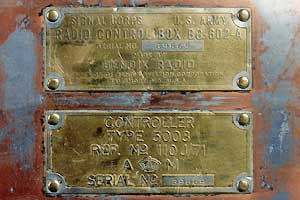 |
| Type plates of the board radio of the plane. |
The third and last flight of a Boeing B-17-G Flying Fortress, serial number 42-107038.
The plane left the Boeing factory on Long beach and was delivered to the American Airforce on February 3rd, 1944. On February 9th, 1944 it was handed over to the 447th Bomber group (H), 710th (H) Squadron.
After having seen 43 days of action the plane crashed in Amsterdam on March 22nd, 1944.
The crew consisted of 10 people who were:
- Edward Welling Stull, 2de Luitenant, (1918-1992), pilot
- Samuel France Showalter, 2de Luitenant, (1919-2004), co-pilot
- Harold Joseph Grace, 2de Luitenant, navigator
- John Edward Tayloe, Sergant (1924-2008), bombardier
- Paul Joseph Geis, Sergant, top turret gunner
- David Eugene Stowers, Sergant, radio operator
- Frank Ignatius Barry, Sergant (1922-2011) bal turret gunner
- Alfred Sanchez, Sergant (1923), tail gunner
- Hermann Iventosch, Sergant, left waist gunner
- Louis Joseph Zommer, Sergant (1919), right waist gunner.
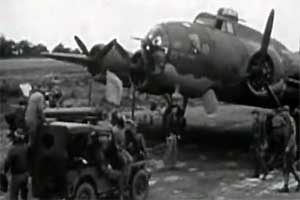 |
| Picture from a US Army information reel. See some scenes from the movie: .MOV (1,2 Mb). |
After a few practice flights from the home base in America, the plane was flown over to Rattlesden Air Force Base (Station 126), north-west of London in England.
The plane had made 2 successful flights before the last fatal one.
On March 22nd, 1944 they left on a mission which the USAAF Chronology lists for the "European Theater of Operations" on this day:
STRATEGIC OPERATIONS (Eighth Air Force): Mission 273: 474 B-17s and 214 B-24s are dispatched to bomb aviation industry plants at Oranienburg and Basdorf, Germany but 8/10 to 10/10 cloud cover prevents an attack; the bombers hit the secondary target, Berlin, and targets of opportunity; the bombers also drop 6.368 million leaflets; 1 bomber is damaged beyond repair and 347 bombers are damaged; casualties are 20 WIA [Wounded in action] and 135 MIA [Missing in action]. Details are:
1. 460 of 474 B-17s [Flying Fortress] bomb Berlin; 7 B-17s are lost.
2. 196 of 214 B-24s [Liberator] bomb Berlin and 1 bombs Heide; 5 B-24s are lost.
Escort is provided by 125 P-38s, 496 Eighth and Ninth Air Force P-47s and 196 Eighth and Ninth Air Force P-51s. There is no air combat and the only claim is for 1-0-0 Luftwaffe aircraft on the ground by P-47s. Details are:
1. 3 P-38s [Lightning] are lost and 7 damaged; 3 pilots are MIA.
2. 5 P-47s [Thunderbolt] are lost, 1 damaged beyond repair and 9 damaged; casualties are 1 WIA and 5 MIA.
3. 4 P-51s [Mustang] are lost and 2 damaged beyond repair; 4 pilots are MIA.
After dropping the bombs on an aircraft production installation they headed back to the home base. During the journey they were hit by flak. In a report from the American Airforce it is desribed as:
"Acrft was believed hit by flak by the Southern Bremen Defenses. #5 engine was hit and smoked, #4 prop was feathered. Acrft contd flight to right of formation losing altitude and was last seen in level flight over the Zuiderzee, apparently under control. 5-7 chutes were observed."
Destination: Amsterdam
In the vicinity of Bremen the pilot, Stull, gave five crew members the order to jump. They were: Stoyer, Barry, Sanchez, Eventosch en Zommer. They landed near Nordhorn (District Bentheim, Germany), were quickly made P.O.W.’s and taken to Dulag Luft, the interrogation camp for the allies.
The last known location at 14:45 hrs. on March 22nd, 1944 was at co-ordinate 52.38N-04.41E near Bergen Airfield in North Holland. The plane was roughly 6 kilometres from the North Sea.
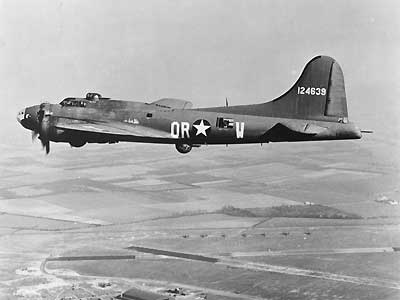 |
| A B-17 Flying Fortress above an airfield in England. (Photo made available by US Air Force Historical Research Agency) |
The co-pilot Showalter told the story of the flight when he returned on March the 22nd 1994, 50 years after the event, to the spot where he crashed in the Bremstraat:
“The plane was returning to base in England after bombing Berlin. It appeared that the plane was hit in one of the 4 motors. The fire was extinguished in time. That turned out to be a stay of execution as the plane was struck once again. This time a shell hit not only the wing but the communication panel. The panel malfunctioned leaving the pilot with no choice but to go over to manual control. The plane continued losing altitude. Above Purmerend the crew tried to fix the wiring so that the plane would come down in the North Sea.”
Fellow crewmember John Tayloe told in 2005: "I haven't seen 'my' B-17 crash myself. I heard later from the pilot, with whom I was emprissonend in Amsterdam, the plane hit a school". He visited the location where his parachute landed and the location of the crash in april 2005. See 'An American back in Holland' for a full report of the visit.
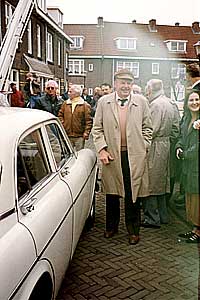 |
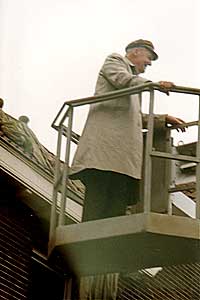 |
| 50 years after the event, Pilot Sam Showalter visited the spot where he parachuted down onto the roof of 23 Bremstraat, Amsterdam-North. Sam died in the spring of 2004. | |
But the pilot Stull made the fatal decision to fly, not to the North Sea, but to continue the flight in the direction of Purmerend. The crew members Grace, Tayloe and Geis left the aircraft near Ilpendam. Grace was the navigator and this was thought to be the reason why the pilot let the plane drift towards Amsterdam.
Crashed without crew
The only two remaining were the pilot Stull and co-pilot Showalter. They were hit again by German anti-aircraft fire in the vicinity of Durgerdam and were fired upon again by a German warship lying for repairs in the ADM shipyard on the Meeuwenlaan.
In the vicinity of Amsterdam Showalter decided to evacuate the plane. He parachuted down and landed on the roof of a house in the Bremstraat in the north of Amsterdam. Within a short space of time he was caught by the Germans.
The daily police report stated: “O.W. Bartel (4104) reports that at approximately 15.20 hrs., a parachute from a shot at aircraft landed on the roof of number 8 Bremstraat. The parachutist’s leg has probably been broken during the landing. A shot was fired by one of the German military present at the scene. The parachutist was taken away by the German armed forces. Quadruple copies to room 16 H.B. Telex message sent (Message service group II no.27) (Source: NIOD).
While they flew over the city, they were also fired upon by a gun boat from the German navy which was moored at a revision firm for repairs on the Korte Princengracht. The plane managed to escape this fire and headed towards Zaandam and the Spaarndammerbuurt.
There was no holding it and the pilot Stull jumped out in the area of the Noordkade (near the Wester Suikerfabriek –Sugar Factory) while the Germans fired on the plane from the ground. He landed safely and was arrested by the Germans. Seconds later the plane ploughed into the R.C. junior school, St. Alfonsus at number 63 Westzaanstraat. Three people died and five were seriously injured in the crash.
The pilot Stull was taken to the Wester Gasthuis Hospital (Wilhelmina Gasthuis), where he rejoined Showalter who had broken his ankle while landing. The three crew members who had landed near Ilpendam were brought to Amsterdam. After a week they were transported together with Stull and Showalter to Durchgangslager der Luftwaffe Dulag Luft (near Frankfurt am Main). The five crew members who landed near Bentheim were also sent there.
All ten crew members later came together in the P.O.W. camp Bath Luft 1 near Peenemunde.
They were liberated in May 1945 by the Russian army and six months later the whole crew of the crashed bomber were home again.
At the crash site
According to a report of March 22nd by the civil air protection service of the Amsterdam municipality there were three people dead of which two were mentioned by name and the third as 'unidentified'.
- M. Baarslag, 59 I Grote Bickerstraat
- Fr. Houttuin, 285 III Orteliusstraat
- a not identified person
Willem Jun (a brother-in-law of Houttuin) had a grocery in the Hembrugstraat. De Germans had confiscated his truck and he had bought a hinny with a cart. Jun was, together with Houttuin shortly at home just before the crash. The hinny became uneasy because of the shooting and Houttuin tried to calm it down. Jun was not present, he was still in his home. The aircraft wing flew alone towards the vicarage and hit Houttuin and the hinny. Because of the burning fuel there was not much more left of both except for some metal parts of the cart.
Five seriously wounded persons were transported to the Wester Gasthuis hospital:
- Gr. Faile-Jonkman, 65 III Westzaanstraat
- D. Kullman- Feind, 149 II Kinkerstraat
- van Saane, 4 I Sanderijnstraat
- J. Sijtzel, 71 I de Wittenkade (who died a few hours after the crash.)
- C.Berlips- Rosenschoon, 65 II Westzaanstraat
Additionally there was one lightly wounded person (H. J. Bon, 9 I Zaandammerplein).
The report also lists these buildings as being damaged:
- Sint Vincentiusschool, Westzaanstraat (incorrect name)
- 56-58 and 65-67 Westzaanstraat (fire- and glass damage)
- 56-58 Spaarndammerstraat (fire- and glass damage)
- 12-24 Westzaanstraat (glass damage)
- 54 Spaarndammerstraat (glass damage)
Furthermore a fuel tank landed in the garden of the vicarage of the Maria Magdalena church along the Spaarndammerstraat. De German field police was notified about this.
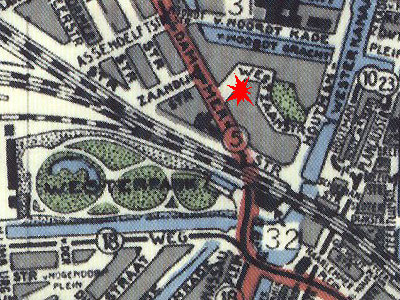 |
| The point of impact in the Westzaanstraat and the area around it. (Marked on a detail of a map of Amsterdam, published by the English government during the war) |
A report of the State police (100 Spaarndammerstraat office) of March 22nd, 1944 provides this information:
"At 9.00 o'clock the Lieutenant van Manen, reports an aircraft of a yet unknown nationality crashed around 15.15 o'clock. partially on the Roman-Catholic school in the Westzaanstraat . Because of the arisen fire the school and houses in the Westzaanstraat suffered fire and glass damage. As well the vicarage at 11 Spaarndammerstraat. Three people died because of this accident, a third victim has not been identified. Four persons were wounded seriously."
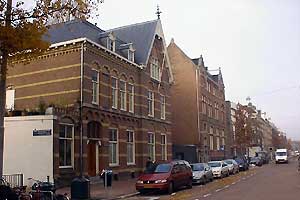 |
| The vicarage of the demolished Maria Magdalena church at the Spaarndammerstraat 9. The broken loose wing and fuel tank hit this building. |
"Additionally several people, who were injured by glass, needed first aid. Both the dead and injured are in the Wester Gasthuis. At this crash, also a horse was killed, the cadaver will be removed by the slaughterhouse. It is assumed there is a crew inside the cockpit, which lies on the roof of the school. The police is guarding there. The traffic was blocked for about two hours. The vicinity of the accident is being guarded by Order-Police."
A summary of the diary of the fire brigade, also dated March 22nd, 1944:
"At 15.32 hr the fire brigade received eight phone calls and from two public fire alarms reports about a fire in the Westzaanstraat and partially in the Spaarndammerstraat.
The fire brigade deployed with great material from the posts: Haarlemmerplein, Prinsengracht, de Ruyterkade, Rozengracht and Nieuwe Achtergracht, also the fireboat Jan van der Heijden went to the place of the accident. Additionally the secondary posts at Markthallen, Brouwersgracht and Tweede Helmerstraat turned out. In total the fire was battled with: 5 engine pumps, 2 ladder carriages. 1 personnel carriage, 1 tools carriage, 1 hose carriage and 5 extra engine pumps.
It turned out to be an extensive fire, which took 2.30 hr to master and the damp down took 23 hours. At first 75 firemen were combating the fire, in total 115 persons took part in extinguishing it.
A total of 1.440 metres of fire hose was rolled out, with which 336.000 litres industrial water and 576.000 surface water with 16 jets was put over the fires. The weather was dry that day and the wind direction was North."
Eyewitness report
On September 15th, 2004 I placed a call for help on the local radio of the North-Holland province to see if someone had pictures of the crash in his possession. No pictures turned up but about twenty people reacted to the call. Below is the eyewitness report of Ben van den Broek:
" I was at home when the plane crashed. We had heard the shooting at the airplane and saw it trying to flee like a hit bird. First in the direction of the Hembrug (NW), then towards Amsterdam-North and finally straight towards us.
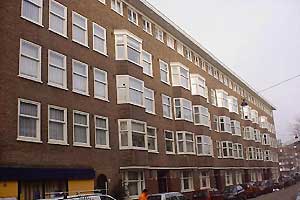 |
| The Westzaanstraat 24/4 were a house and attick room was damaged by fire. |
With about eight people we were watching at the corner Spaarndammerstraat - Westzaanstraat. When the plane came straight at us, we ran towards our home. I stood there with Boere Dirk of the pub (Dirk de Vries - pubowner at the corner), Dik de Bruin (grocer next to our home) and Amende (milk salesman also next to our home). The planed fell on the school during which one wing broke off.
Luckily we had ran away because a few seconds later the broken off wing with a half filled fuel tank flew past us. A straight line from the roof of the school, past some houses and sheaf over the road until it hit the vicarage. No one was in the front room, the room of the vicar was behind it near the garden. Next to the front room was the dining room for the priests and at the other side was a fence of the garden of the sister convent.
The plane lost a lot of fuel from its broken piping during its fall and because of scratching along roofs and walls sparks ignited the fuel. This is how burning fuel spouted inside the home of aunt Griet Faillé and ms. Berlips which wounded them badly.
The street was filled with black smoke immediately and at home we saw the remains of a wing and the damage. We lived at number 48 and in the backyards of numbers 38-40 a large part of the propeller had landed. Because of the smoke and because we had no idea what to do, we fled towards the community building.
For this we needed to cross the Westzaanstraat and at the crossing it appeared the street was burning. Burning fuel flowed over the street with flames of about 10 to 20 centimetres high. There we had to go through. One was actually walking with the crowd.
With about four people we were let in at the Family Tilburg (Spaarndammerstraat 27) and awaited further news. The two women with burns were at first brought to the community building. Aunt Griet (as we all called her) was luckily not burned in her face but her arms were. Ms. Berlips had quite burned her face.
The planes' fuselage eventually ended on the street were we, street boys, foraged around for special items. During those days we had lots of glass. Pieces of almost 5 centimetres from the cockpit. It consisted of thin layers of glass and something like mica. There was also a lot of plexiglas and the neighbour man made bracelets from this."
Resistance in trouble
De R.C. Elementary school Sint Alfonsus in the Westzaanstraat was also used by the resistance. Hence, the crash of the plane caused several problems. How and by whom the school was used for resistance activities is unknown.
Suasso da Limo de Prado, one of the teachers and a Portuguese Jew, would have been involved with hiding munition and people in the school. Headmaster J.A. Keepers would have been appalling angry because it could have put the pupils in danger.
The daughters of Keepers (around 10 years old at the time) remember their father as being member of the resistance himself. In the evening and night he would have been involved in meetings of the resistance, transferred hidden people and Englishmen and hid weapons and munition.
Another location had to be found after the bomber had crashed and one was afraid the Germans would find the hidden weapons. At least Keepers went into hiding for an unknown time. His wife and vice-schoolmaster A. Koenis were taken several times to the school by the Germans to designate the hiding place.
Later the German Green Police put his wife, two daughters and mr. Koenis against the wall with two armed Germans in front. None of the them would have known the hiding place and the Germans didn't find anything.
Pupils
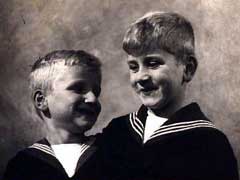 My brother and I were pupils of the Sint Alfonsiusschool. It was a wednesday afternoon and I was free but my brother had to return to school in the afternoon for singing lessons. Like a miracle the rehearsal did not continue because the teacher had suddenly been ill. If the lessons did had continued, then probably all thirty pupils would have been killed because the plane crashed exactly on their classroom.
My brother and I were pupils of the Sint Alfonsiusschool. It was a wednesday afternoon and I was free but my brother had to return to school in the afternoon for singing lessons. Like a miracle the rehearsal did not continue because the teacher had suddenly been ill. If the lessons did had continued, then probably all thirty pupils would have been killed because the plane crashed exactly on their classroom.
Also headmaster Keepers would have been with sixth graders (group eight) on the top floor. They would have been sorting oranges, which were supplied for free during the war.
After half an hour he was called away for an urgent meeting with his publisher in Den Bosch - he was writing a new language method - and the pupils were sent to home...
The personal involvement is the reason why I am still trying to find out what happened back then. I have searched several archives for information, such as of the fire brigade, police and NIOD (Netherlands Institute for War Documentation) which partially succeeded.
If you have more information available or in the possession of a picture, please wil you share this with me?
Emiel Ros
Sources
- Missing Air Crew Report (MACR3338).
- Newspaper article from a newspaper in the resistance museum in Amsterdam.
- Extract of the daily report of the civil air protection service of March 18-25, 1944, City archive of Amsterdam.
- USAAF Chronology.
Thanks to Ben van den Broek for the three pictures and his witness account about this incident.